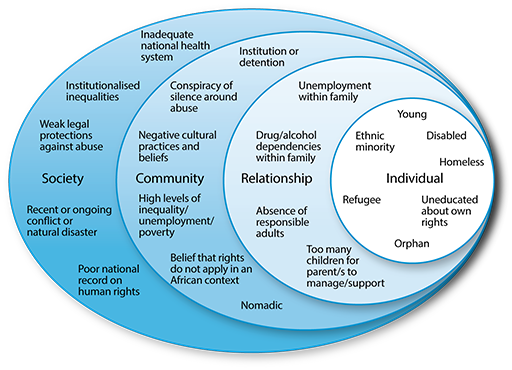3.5 Risk factors for violence
Since ancient times there have been records showing that children have suffered abandonment, cruel and humiliating punishment, sexual abuse, neglect, and even murder and other violence from adults. This has occurred in every country in the world in a whole range of forms and settings. All children, everywhere, are vulnerable to abuse of any kind but research finds that certain conditions increase the risk factors.
Figure 3.1 below shows a model that demonstrates the layered nature of the risk factors for violence. This is known as an ‘ecological model’ which shows how an individual person is influenced by lots of other factors in their family, the community and the wider society.

We can perhaps understand this diagram in relation to risk better by grouping some of the most commonly recognised risk factors within each of the layers of the model (Figure 3.2). You might want to adapt the model to take account of your particular community and context. Obviously the specific risks will vary in different situations.

By looking at this model, you can begin to see the factors that expose children to risk of violence can take place at many levels. For example, a child may be more vulnerable because he or she has a disability (individual level). However, the risks will be much greater if the family is very poor (relationship level), the community has negative views towards disability (community level) and the government has failed to provide any protective laws and services to ensure that families with a disabled child are properly supported (society level).
The most powerful factors in the protection of children are:
- the development of strong bonds of attachment between parents and children
- the building of positive relationships within loving, safe and stable family units
These need to be supported by:
- communities that recognise and nurture the rights of their children within positive cultural norms
- societies that have a strong legal framework to reject all forms of abuse.
Together these conditions provide the wider layers of protection that help minimise the risks for violence.
Activity 3.3 will help you see the connections between the layers in deciding how much a child is at risk.
Activity 3.3: Prioritising risk factors
Rearrange the following list in order of risk, so that the child at greatest risk of abuse is at the top, and lowest risk is at the bottom. Consider each case as it applies to the same 10-year-old boy.
If you are working with colleagues – discuss each one in turn and see if you can agree.
Make notes explaining why you think each situation is risky or less risky.
- A boy living with his parents in a refugee camp.
- A boy living with his parents in the same village as his grandparents and other extended family.
- An orphan boy living and working on the street.
- A physically disabled boy living with his parents in a refugee camp.
- An orphan boy living in a children’s home.
| Which situation? | Why is this situation risky or less risky? |
|---|---|
|
|
|
|
|
|
|
|
|
|
|
|
Compare your answers to those at the end of the study session.
3.4 Defining violence
